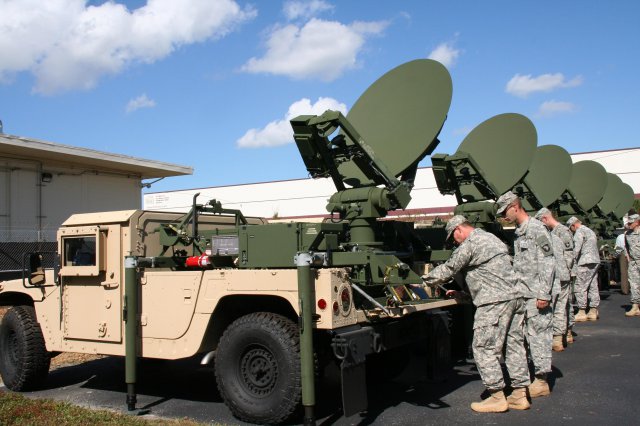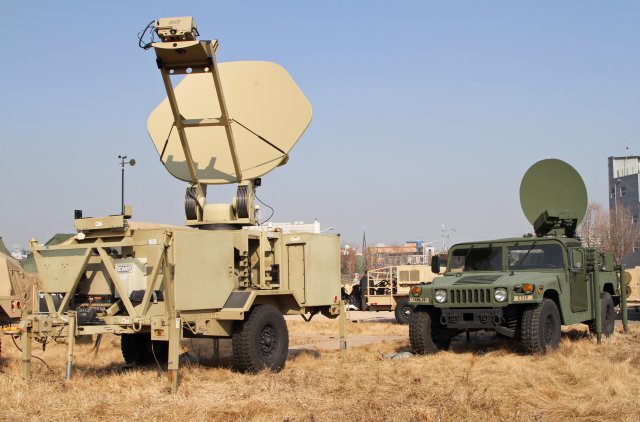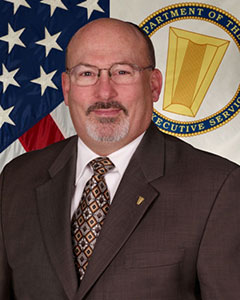
Army soldiers train on SMART-T terminals for AEHF satellite communications.
ARLINGTON: As the Army hardens its networks against Russian-style jamming and hacking, it can’t afford the time or money for another high-tech, high-cost, multi-year mega-program like the failed Future Combat Systems. Instead, the service mostly has to make the best of what it has. That requires an array of unglamorous improvements to its crucial networks:
- standardizing a dizzying array of networks to the same software baseline;
- simplifying software so young soldiers can use it without specialist contractors on call;
- streamlining hardware so it can be deployed rapidly and set up quickly in the field;
and, sometimes, dusting off forgotten tech and asking, in the words of the Army’s Program Executive Officer for Command, Control and Communications – Tactical (C3T), “how the hell do we turn these on?”

Army STT (left) and SMART-T (right) satellite terminals during an exercise in South Korea.
SMART-Ts In The Motor Pool
Consider SMART-T, a militarized satellite terminal that can withstand not only jamming but electromagnetic pulse from nuclear bombs. It’s exactly the kind of communications gear you’d want for a war with Russia, with its electronic warfare battalions and “escalate to deescalate” nuclear doctrine. But where do you get it?
“We actually had a case — I won’t even mention the unit — where….the S-6 (signals officer) told us that they were wondering how they could get access to SMART-Ts,” said Gary Martin, the PEO-C3T. “We said, ‘well, you’ve got them, we fielded them to you in 2006.’ (The S-6 said), ‘Well, I don’t think we’ve got ‘em.’ And so we had to physically show them. They were parked in the back of the motor pool. They’d never used it.”

Gary Martin
“The Army really has one system that was designed to be robust against that (jamming threat),” said Martin: the SMART-T, upgraded to use Advanced Extremely High Frequency (AEHF) satellites. But they were never issued to all the low-echelon tactical units that might use them. “They’re at brigade level or at division level or at corps level,” says Martin. Even higher headquarters didn’t bother bringing them to Afghanistan or Iraq, where the jamming threat was non-existent, he adds, noting “They’ve been parked in motor pools for 10 years.”
The Army is now retraining soldiers — or training them for the first time — on SMART-T systems that have, often, never been used. Units are taking them into simulated but intense battle at the National Training Center and Joint Readiness Training Center. There’s a steep learning curve, Martin told an Association of the US Army conference here. “How the hell do we turn these on? It’s not a simple system. (In fact), it’s the most complicated of our satellite systems,” he says, requiring monthly updates of ephemeris data just to know where the satellites are.
The Army is upgrading the satellite modems on other systems, such as WIN-T, its flagship tactical network, “but. quite frankly, if we really want to get after this in a big way, we need a new constellation (of satellites) that can protect small tactical terminals,” Martin said. “Right now that’s well beyond 2030, so we’re going to find some fixes in between.”

The 63rd Theater Aviation Brigade’s Tactical Operations Center (TOC), nicknamed the “TOC Mahal.”
Keep It Simple, Stupid
What kinds of near-term fixes can the Army afford? For one thing, it needs to make the technology it already has much easier to use. Military IT should be as intuitive as iPhones and Androids, said Maj. Gen. Peter Gallagher, who’s director for architecture, operations, networks, and space for the Army’s Chief Information Officer.
“What we’re learning after 17 years of war and multiple years out at NIE (Network Integration Evaluations), is what we have out there is far too complicated for our soldiers,” Gallagher told the AUSA conference. “When they’re in a contested space against a peer adversary and they’re fighting for their lives, they don’t need to be worrying about configuration. They need to be able to make the connection to get what they need,” be that artillery support, emergency resupply, or medevac for their wounded.

Forward Operating Base (FOB) Hammer, typical of the extensive infrastructure set up in Iraq.
Complexity isn’t just a training problem. It’s an operational problem. Systems that only function in the hands of highly trained contractors — the term of art is Field Service Representatives, or FSRs — were awkward but workable in Afghanistan and Iraq, where US troops rotated in and out of well-established Forward Operating Bases. In a Korean crisis, Eastern European war, or Third World flare-up, US forces would have to rapidly deploy all their equipment and people, set up their networks quickly and keep them running with little or no support. The more complex the system, the more shipping containers and personnel a unit must deploy, feed, and defend to keep it running. Ironically, deploying units face a harder technical challenge than fixed bases, but have fewer resources to solve it.
“(At) any fort in the Army …those networks are not all that different from what we put inside our tactical systems,” Martin said. The difference, he went on, is that on base, “you have a network enterprise center that’s 30 to 40 people, they’re all credentialed, and their job is to keep the network up. That’s all they do.” (Even so, “every 3rd VTC I do, I get dropped,” Martin groused, to laughter.) “On the tactical side,” he went on, “we’re taking the same stuff, shoving it into transit cases in our vehicles, and asking 21, 22, 23-year-old kids to run the network: get the coms up, set up the network, make sure it works, defend it.”
The crucial challenge, Martin said, is “how we do we build a more intuitive interface” for those hard-pressed young soldiers? Commercial vendors may not solve this problem for the Army, which accounts for a small fraction of their sales and has niche demands most users don’t. “The COTS (Commercial Off The Shelf) industry is not motivated to solve that problem,” Martin said. “They don’t see that as a problem.”
One thing the Army can simplify in the near term, however, is its bewildering variety of software. Currently it uses three different command-and-control programs (FBC2, JBC-P, and JCR), each with multiple versions in service, each upgraded to a slightly different degree. Martin’s office is now working to “get the entire Army to one common software baseline” by 2019, he said. To do all the upgrades, he said, “we have to go out and touch 400 units” — some of which, especially in the Guard and Reserve, will require new hardware before they can even run the new software.
All this hard work on the network lacks the sex appeal of new weapons. Incremental upgrades lack the critical mass of homestate jobs that give major programs their political staying power. But this low-key labor is critical to creating an army that can keep communicating — and therefore keep fighting as an organized force — in the face of high-tech adversaries.
Army eyes TBI monitoring, wearable tech for soldiers in high-risk billets
“We are also looking at what additional personal protective equipment we can provide to our folks, especially instructors and others who are routinely exposed to blast pressure,” said Army Secretary Christine Wormuth.


























